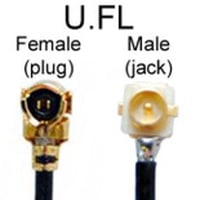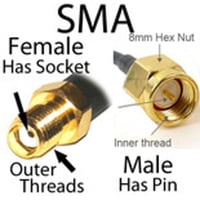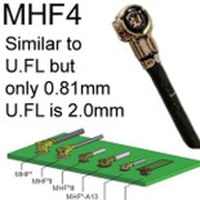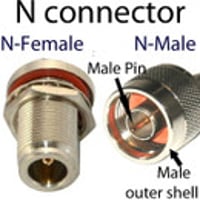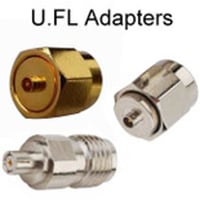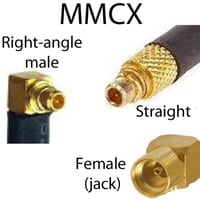U.FL Adapters to SMA and RP-SMA
Adapters to SMA and RP-SMA Adapters to U.FL
Data Alliance provides a complete line of U.FL Adapters and U.FL cables to all types of connectors.

Our U.FL adapters provide miniature interfaces that make them useful in high-density applications such as those used in WiFi computer and GPS applications. Our SMA to U.FL adapters are made of stainless steel and brass bodies and come with a Voltage Standing Wave Ratio of between 1.3 and 6GHz.
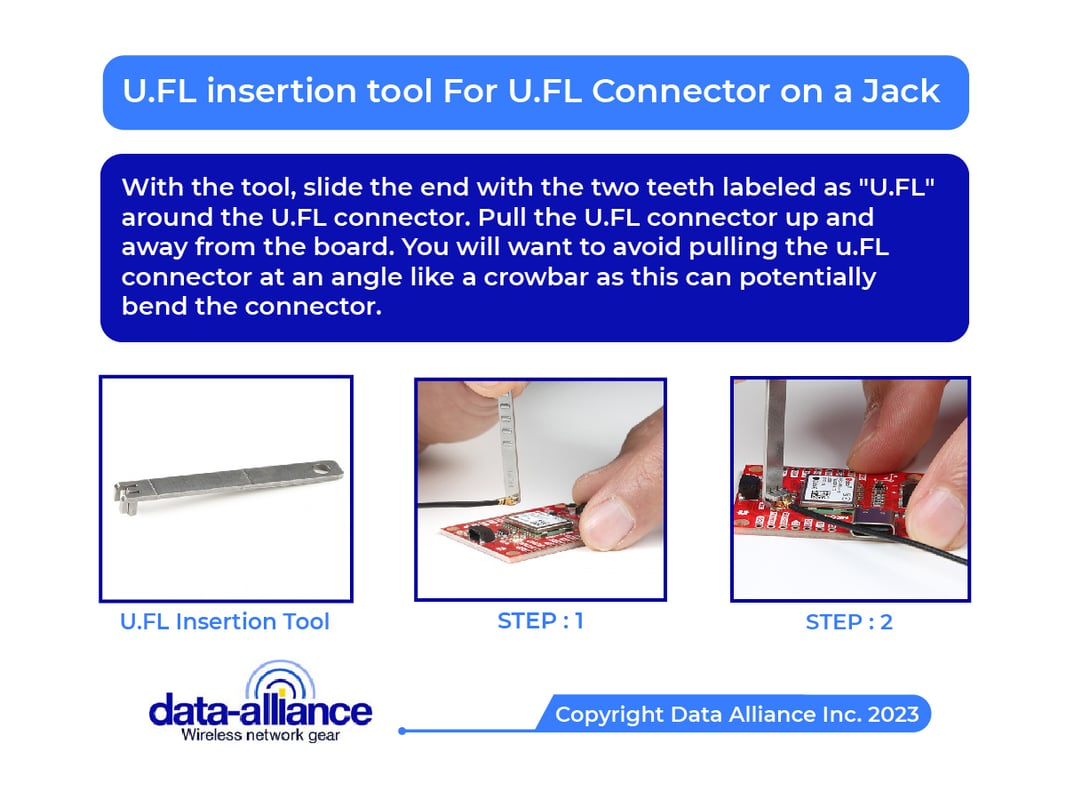
U.FL is also known as UMCC (Ultra Miniature Coax Connectors) - U.FL Series
- U.FL connectors are tiny radio frequency connectors that operate on the 6GHZ high-frequency band. U.FL is used in a wide variety of applications mostly as antenna cable connectors. The series finds use in applications such as GPS connectors, antenna jacks Mini PCI cards, and any embedded systems on which space is critical.
- U.FL connectors are ultra-small surface mounted coaxial connectors typically with a nominal mounting area of 3.2 mm and 3.0 mm and a maximum height of 2.5 mm. Since they work with a wide range of miniature devices, you will typically get high-frequency performance from these connectors right from DC to 6GHz.
- UMCC / U.FL is an ultra low profile coaxial interconnection solution that is designed to meet the demand for miniaturization in the modern world of wireless applications. The U.FL / UMCC cable assemblies come in the form of inter-series assemblies, double ended jumpers and U.FL jack on PCB for board mount applications.
Most can be connected with automatic placement equipment with vacuum nozzles given that they come packaged on reel and tape. Proper use of extraction tools ensures that connection and disconnection between the receptacle and plug is smooth. You will often get a tactile click when the connector is fully mated to the receptacle.
The U.FL series of connectors works with a variety of adapters that make it suitable for a range of applications that include Bluetooth, cell phones, Wireless LAN, Smart Phones, GPS, Wireless Communication Devices, the Internet of Things (IoT), Electronic Measuring Instruments and applications using small coaxial connectors for high frequency transmissions.
U.FL to SMA & RP-SMA Adapters & Adapter Cables
A U.FL to SMA adapter is a short length of mini or micro coax capped at the ends with: [A] a U.FL connector at one end, and [B] an SMA connector at the other. It is also known as a U.FL to SMA pigtail, U.FL to SMA cable, an SMA transition cable, a cable assembly with U.FL to SMA connections, or U.FL to SMA adapter cable. [A] The miniature UFL connector by Japanese manufacturer Hirose, and compatible contemporary radio frequency connectors such as the I-PEX, IPX, and UMCC,are built to cope with RF transmission frequencies up to 6 GHz. [B] Sub-Miniature version A or SMA connectors are a common type of screw fixing radio frequency connector which can cope with frequencies up to 18GHz, well into the microwave range. They are not to be confused with the reverse polarity or RP-SMA connector as though some structural similarities exist, they are incompatible (more on this below). The interconnecting length of coaxial cable can use varying gauges and types of mini-coax including 1 .13, 1.32, and RG 174. Lengths available range from a few inches to several feet.
U.FL connectors
DEEP DIVE: This is an extremely small connector with a mated height of just over 2mm, one of the lowest in the world. U.FL connectors are also lightweight weighing around 50mg depending on the caliber of coax cable to which they are attached. Structural characteristics: These connectors consist of a shell, and the male or female central contact surrounded by an insulator. The shell is fabricated from phosphor bronze, with a silver-plated finish.
- The male connector is a surface-mounted connector or 'plug' with a central solid pin. The pin is made from brass and is surrounded by a polybutylene terephthalate (PBT)insulator.
- Female connectors or "jacks" have a central receptacle for the male pin. This is made from phosphor bronze with a liquid crystal polymer (LCP) insulator.
Sure mating carries a clicking sensation. The connection is resistant to shock, vibration, humidity, salt spray, and variations in temperature. These tiny RF connectors were not designed for repeated reuse and are rated for only 30 mating cycles. Electrical profile: The impedance across the ufl connector is 50 ohms. V.S.W.R is 1.3. It has a rated voltage of 60V and is capable of being used with frequencies up to 6GHz. Applications: As it occupies such a small area, it is routinely used on printed circuit boards (PCBs). It is particularly desirable for wireless networking solutions such as WiFi, GPS, or Bluetooth. The characteristics of this connector class lend it to a range of applications where a miniature RF connector is needed because space is a premium.
- Within mobile phones and other devices so they can utilize wireless communication.
- Within laptops, in particular, to connect a WiFi antenna to the PCB.
SMA connectors
A quick guide: Though sub-miniature, SMA connectors are larger than the U.FL connector and strong and durable enough for repeated matings. They are also described as being semi-precision, meaning that they are manufactured with an accuracy of measurement within the range of 1/64 to 1/100 of an inch. Structural characteristics: SMA connectors are manufactured in line with the US military (MIL) standards that originally specified their use. They consist of:
- a body
- coupling hex nut,
- inner male or female contact
- an insulator
- a rubber gasket
- and a crimp ferrule
The connector body is typically made from brass or stainless steel and may be gold-plated. The inner connectors are made from brass or copper with gold plating. Male and female components for a mating connection through screwing the threaded bodies together so that the inner pin engages with its reciprocal female inner part. A special wrench may be used to tighten the connectors. Electrical profile: This connector is capable of handling frequencies up to 18 GHz with minimal loss and reflections and 50-ohm impedance. Depending on its size, the V.W.S.R of the SMA connector ranges from 1.05 to 1.2. Applications: This hardy connector has a wide range of radio communications uses including:
A conversion of size and caliber:
The U.FL to SMA Cable assembly performs the following key functions needed by combining these two popular classes of radio frequency connector.
- It allows a flexible transition in size between the tiny U.FL and the larger SMA connectors.
- UFL SMA adapters protect the radio frequency performance of the set upon which they are used as the impedance remains the same throughout the assembly.
- A UFL to SMA pigtail facilitates increased connectivity in small spaces.
- In RF setups, robust and more easily handled SMA connectors can be used to make repeated matings, leaving the U.FL connector undisturbed. Repeated mating cycles of a U.FL may damage it.
- The SMA connector is found on a variety of antennas and therefore can be used to connect an antenna to a PCB via the U.FL connector.
This makes a U.FL to SMA cable an essential component in a range of applications, especially where RF connections and antenna upgrades are needed within the circuitry of a device. The length of micro coax between the two connectors can vary to accommodate the connection of an externalized antenna within a device. The SMA portion of a SMA to U.FL adapter may be male or female, but the U.FL. portion is always female.
Frequently asked questions for U.FL to SMA adapter
- Is an SMA connector the same as an RP-SMA connector?
If purchasing a U.FL to SMA adapter it is important to ensure that a U.FL to RP SMA assembly is not needed as SMA and RP SMA connectors are not interchangeable. Reverse polarity SMA connectors switch round the gender of the inner pin connector, creating
- a female connector body with a male pin, and
- a male outer threaded body with a female contact within.
Until recently the SMA-RP connector had a special status in FCC guidance which stipulated that certified WLAN devices must be designed in such a way that no antenna other than the originally installed antenna can be used with the transmitting device. This was originally done to ensure that WLAN devices would be used with antennas other than those they were certified to operate with. To comply with this, manufacturers preferentially used the SMA-R connector, hence this connector is most often used for WiFi and other WLAN applications.
- Can any type of coax cable be used with a U.FL connector?
The UFL connector is simply too small to accommodate any but the smallest coax sizes. As mentioned above, compatible coax sizes include:
With such small sizes, flexibility and signal loss can be an issue. Choosing a ufl to sma adapter that has a length of coax with double shielding such as 1.32mm can improve performance. Larger cables such as RG 174 will need to be stripped down to attach the inner conductor to the ufl connector. This is not known to cause problems with the assembly's performance.
- How can I take care of a U.FL connector?
These miniature connectors can be very difficult to handle. Following these pointers can improve their longevity.
- Prevent contact with grime, dust, and use clean hands when using this connector.
- Avoid unnecessary or excessive force or bending on ufl connectors. If damaged, they will not function.
- To attach the female ufl connector to its male counterpart, pinch its cable 2cm (0.79 inches) from the connector. Holding the connector in this position, align it over the male mounted connector and check its positioning. Once centered over the male connector, use the center of one finger to press the female connector down and feel for a palpable locking sensation.
- You can protect your SMA to UFL assembly by using 'strain relief' methods like threading the cable through a mounting hole on the circuit board, or lightly taping down the cable to prevent unwanted movements that could disrupt the assembly.
- A U.FL connector can be disconnected in a controlled manner by using a pair of tweezers to gently lift the female connector off the male.
Rounding up SMA to U.FL adapters adds great utility to your radio frequency setup as the combination of these two classes of connectors facilitates greater and more reliable connectivity than can be achieved with a single type of connector. U.FL to SMA connectors are particularly useful for allowing downstream connections to a circuit board without disturbing the miniature UFL connector. Also evaluate the type and length of coax cable used in your adapter assembly, as this also may impact overall RF performance.
LEARN MORE:

